Recent Abnormal Hydrologic Behavior of Tibetan Lakes Observed by Multi-Mission Altimeters
Abstract
1. Introduction
2. Materials and Methods
2.1. Study Region
2.2. Study Data
2.2.1. LEGOS Hydroweb and DAHITI Altimetry Data Archives
2.2.2. Supplementary Altimetry Data
SARAL/AltiKa Data
Sentinel-3/SRAL Data
2.2.3. Climate Data
2.3. Methods
2.3.1. Altimetry Water Level Processing
2.3.2. Removal of Measurement Outliers
- Step 1:
- We removed the outliers that were more than 3 standard deviations from the median for all the measurements.
- Step 2:
- We removed the data other than twice the standard deviation for single-day measurements.
2.3.3. Unifying the Reference System of Different Altimetry Sources
3. Results
3.1. Long-Term Lake Level Variations Based on the Hydroweb and DAHITI Data Archives
3.2. Lake Level Variations Based on SARAL and Sentinel-3 Altimetry Data
3.3. Spatial Distribution of Lake Level Changing Rates During 2016–2018
4. Discussion
4.1. The Driving Factors of Abnormal Lake Level Changes
4.2. Spatial Linkage of Increased Precipitation to Enhanced Water Vapor Circulations
5. Conclusions
Supplementary Materials
Author Contributions
Funding
Acknowledgments
Conflicts of Interest
References
- Lehner, B.; Döll, P. Development and validation of a global database of lakes, reservoirs and wetlands. J. Hydrol. 2004, 296, 1–22. [Google Scholar] [CrossRef]
- Palmer, S.C.; Kutser, T.; Hunter, P.D. Remote sensing of inland waters: Challenges, progress and future directions. Remote Sens. Environ. 2015, 157, 1–8. [Google Scholar] [CrossRef]
- Sheng, Y.; Song, C.; Wang, J.; Lyons, E.A.; Knox, B.R.; Cox, J.S.; Gao, F. Representative lake water extent mapping at continental scales using multi-temporal Landsat-8 imagery. Remote Sens. Environ. 2016, 185, 129–141. [Google Scholar] [CrossRef]
- Shi, K.; Zhang, Y.; Liu, X.; Wang, M.; Qin, B. Remote sensing of diffuse attenuation coefficient of photosynthetically active radiation in Lake Taihu using MERIS data. Remote Sens. Environ. 2014, 140, 365–377. [Google Scholar] [CrossRef]
- Smith, L.C.; Sheng, Y.; MacDonald, G.; Hinzman, L. Disappearing arctic lakes. Science 2005, 308, 1429. [Google Scholar] [CrossRef]
- Song, C.; Huang, B.; Ke, L. Modeling and analysis of lake water storage changes on the Tibetan Plateau using multi-mission satellite data. Remote Sens. Environ. 2013, 135, 25–35. [Google Scholar] [CrossRef]
- Vörösmarty, C.J. Global water assessment and potential contributions from Earth Systems Science. Aquat. Sci. 2002, 64, 328–351. [Google Scholar] [CrossRef]
- Wang, J.; Sheng, Y.; Tong, T.S.D. Monitoring decadal lake dynamics across the Yangtze Basin downstream of Three Gorges Dam. Remote Sens. Environ. 2014, 152, 251–269. [Google Scholar] [CrossRef]
- Pekel, J.-F.; Cottam, A.; Gorelick, N.; Belward, A.S. High-resolution mapping of global surface water and its long-term changes. Nature 2016, 540, 418–422. [Google Scholar] [CrossRef]
- Donchyts, G.; Eilander, D.; Schellekens, J.; Winsemius, H.; Gorelick, N.; Erickson, T.; Van De Giesen, N. Monitoring Earth’s reservoir and lake dynamics from space. In Proceedings of the AGU Fall Meeting Abstracts, San Francisco, CA, USA, 12–16 December 2016. [Google Scholar]
- Yao, F.; Wang, J.; Wang, C.; Crétaux, J.-F. Constructing long-term high-frequency time series of global lake and reservoir areas using Landsat imagery. Remote Sens. Environ. 2019, 232, 111210. [Google Scholar] [CrossRef]
- Busker, T.; de Roo, A.; Gelati, E.; Schwatke, C.; Adamovic, M.; Bisselink, B.; Pekel, J.-F.; Cottam, A. A global lake and reservoir volume analysis using a surface water dataset and satellite altimetry. Hydrol. Earth Syst. Sci. 2019, 23, 669–690. [Google Scholar] [CrossRef]
- Wang, J.; Song, C.; Reager, J.T.; Yao, F.; Famiglietti, J.S.; Sheng, Y.; MacDonald, G.M.; Brun, F.; Schmied, H.M.; Marston, R.A. Recent global decline in endorheic basin water storages. Nat. Geosci. 2018, 11, 926–932. [Google Scholar] [CrossRef] [PubMed]
- Qiao, B.; Zhu, L.; Yang, R. Temporal-spatial differences in lake water storage changes and their links to climate change throughout the Tibetan Plateau. Remote Sens. Environ. 2019, 222, 232–243. [Google Scholar] [CrossRef]
- Wan, W.; Long, D.; Hong, Y.; Ma, Y.; Yuan, Y.; Xiao, P.; Duan, H.; Han, Z.; Gu, X. A lake data set for the Tibetan Plateau from the 1960s, 2005, and 2014. Sci. Data 2016, 3, 160039. [Google Scholar] [CrossRef] [PubMed]
- Zhu, L.; Xie, M.; Wu, Y. Quantitative analysis of lake area variations and the influence factors from 1971 to 2004 in the Nam Co basin of the Tibetan Plateau. Chin. Sci. Bull. 2010, 55, 1294–1303. [Google Scholar] [CrossRef]
- Huang, S.; Dahal, D.; Young, C.; Chander, G.; Liu, S. Integration of Palmer Drought Severity Index and remote sensing data to simulate wetland water surface from 1910 to 2009 in Cottonwood Lake area, North Dakota. Remote Sens. Environ. 2011, 115, 3377–3389. [Google Scholar] [CrossRef]
- Song, C.; Huang, B.; Richards, K.; Ke, L.; Hien Phan, V. Accelerated lake expansion on the Tibetan Plateau in the 2000s: Induced by glacial melting or other processes? Water Resour. Res. 2014, 50, 3170–3186. [Google Scholar] [CrossRef]
- Lei, Y.; Yang, K.; Wang, B.; Sheng, Y.; Bird, B.W.; Zhang, G.; Tian, L. Response of inland lake dynamics over the Tibetan Plateau to climate change. Clim. Chang. 2014, 125, 281–290. [Google Scholar] [CrossRef]
- Lu, S.; Jia, L.; Zhang, L.; Wei, Y.; Baig, M.H.A.; Zhai, Z.; Meng, J.; Li, X.; Zhang, G. Lake water surface mapping in the Tibetan Plateau using the MODIS MOD09Q1 product. Remote Sens. Lett. 2017, 8, 224–233. [Google Scholar] [CrossRef]
- Mao, D.; Wang, Z.; Yang, H.; Li, H.; Thompson, J.R.; Li, L.; Song, K.; Chen, B.; Gao, H.; Wu, J. Impacts of climate change on Tibetan lakes: Patterns and processes. Remote Sens. 2018, 10, 358. [Google Scholar] [CrossRef]
- Zhang, G.; Luo, W.; Chen, W.; Zheng, G. A robust but variable lake expansion on the Tibetan Plateau. Sci. Bull. 2019, 64, 1306–1309. [Google Scholar] [CrossRef]
- Song, C.; Huang, B.; Ke, L.; Richards, K.S. Remote sensing of alpine lake water environment changes on the Tibetan Plateau and surroundings: A review. ISPRS J. Photogramm Remote Sens. 2014, 92, 26–37. [Google Scholar] [CrossRef]
- Zhu, J.; Song, C.; Wang, J.; Ke, L. China’s inland water dynamics: The significance of water body types. Proc. Natl. Acad. Sci. USA 2020, 117, 13876–13878. [Google Scholar] [CrossRef] [PubMed]
- Phan, V.; Lindenbergh, R.; Menenti, M. Seasonal trends in Tibetan lake level changes as observed by ICESat laser altimetry. ISPRS Ann. Photogramm. Remote Sens. Spat. Inf. Sci. 2012, 1, 237–242. [Google Scholar] [CrossRef]
- Wang, X.; Gong, P.; Zhao, Y.; Xu, Y.; Cheng, X.; Niu, Z.; Luo, Z.; Huang, H.; Sun, F.; Li, X. Water-level changes in China’s large lakes determined from ICESat/GLAS data. Remote Sens. Environ. 2013, 132, 131–144. [Google Scholar] [CrossRef]
- Zhang, G.; Xie, H.; Kang, S.; Yi, D.; Ackley, S.F. Monitoring lake level changes on the Tibetan Plateau using ICESat altimetry data (2003–2009). Remote Sens. Environ. 2011, 115, 1733–1742. [Google Scholar] [CrossRef]
- Gao, L.; Liao, J.; Shen, G. Monitoring lake-level changes in the Qinghai–Tibetan Plateau using radar altimeter data (2002–2012). J. Appl. Remote Sens. 2013, 7, 073470. [Google Scholar] [CrossRef]
- Kleinherenbrink, M.; Lindenbergh, R.; Ditmar, P. Monitoring of lake level changes on the Tibetan Plateau and Tian Shan by retracking Cryosat SARIn waveforms. J. Hydrol. 2015, 521, 119–131. [Google Scholar] [CrossRef]
- Song, C.; Ye, Q.; Cheng, X. Shifts in water-level variation of Namco in the central Tibetan Plateau from ICESat and CryoSat-2 altimetry and station observations. Sci. Bull. 2015, 60, 1287–1297. [Google Scholar] [CrossRef]
- Project, J.M.M. GHRSST Level 4 MUR Global Foundation Sea Surface Temperature Analysis. Available online: https://doi.org/10.5067/GHGDM-4FD02 (accessed on 19 December 2018).
- Song, C.; Ye, Q.; Sheng, Y.; Gong, T. Combined ICESat and CryoSat-2 altimetry for accessing water level dynamics of Tibetan lakes over 2003–2014. Water 2015, 7, 4685–4700. [Google Scholar] [CrossRef]
- Jiang, L.; Nielsen, K.; Andersen, O.B.; Bauer-Gottwein, P. Monitoring recent lake level variations on the Tibetan Plateau using CryoSat-2 SARIn mode data. J. Hydrol. 2017, 544, 109–124. [Google Scholar] [CrossRef]
- Lei, Y.; Zhu, Y.; Wang, B.; Yao, T.; Yang, K.; Zhang, X.; Zhai, J.; Ma, N. Extreme Lake Level Changes on the Tibetan Plateau Associated With the 2015/2016 El Niño. Geophys. Res. Lett. 2019, 46, 5889–5898. [Google Scholar] [CrossRef]
- Hwang, C.; Cheng, Y.-S.; Yang, W.-H.; Zhang, G.; Huang, Y.-R.; Shen, W.-B.; Pan, Y. Lake level changes in the Tibetan Plateau from Cryosat-2, SARAL, ICESat, and Jason-2 altimeters. Terr. Atmos. Ocean. Sci. 2019, 30, 1–18. [Google Scholar] [CrossRef]
- Kao, H.-C.; Kuo, C.-Y.; Tseng, K.-H.; Shum, C.K.; Tseng, T.-P.; Jia, Y.-Y.; Yang, T.-Y.; Ali, T.A.; Yi, Y.; Hussain, D. Assessment of Cryosat-2 and SARAL/AltiKa altimetry for measuring inland water and coastal sea level variations: A case study on Tibetan Plateau lake and Taiwan Coast. Mar. Geod. 2019, 42, 327–343. [Google Scholar] [CrossRef]
- Zhang, G.; Chen, W.; Xie, H. Tibetan Plateau’s lake level and volume changes from NASA’s ICESat/ICESat-2 and Landsat Missions. Geophys. Res. Lett. 2019, 46, 13107–13118. [Google Scholar] [CrossRef]
- Piao, S.; Cui, M.; Chen, A.; Wang, X.; Ciais, P.; Liu, J.; Tang, Y. Altitude and temperature dependence of change in the spring vegetation green-up date from 1982 to 2006 in the Qinghai-Xizang Plateau. Agric. For. Meteorol. 2011, 151, 1599–1608. [Google Scholar] [CrossRef]
- Xu, Z.; Gong, T.; Li, J. Decadal trend of climate in the Tibetan Plateau—Regional temperature and precipitation. Hydrol. Process. Int. J. 2008, 22, 3056–3065. [Google Scholar] [CrossRef]
- Ma, R.; Duan, H.; Hu, C.; Feng, X.; Li, A.; Ju, W.; Jiang, J.; Yang, G. A half-century of changes in China’s lakes: Global warming or human influence? Geophys. Res. Lett. 2010, 37. [Google Scholar] [CrossRef]
- Crétaux, J.-F.; Calmant, S.; Romanovski, V.; Shabunin, A.; Lyard, F.; Bergé-Nguyen, M.; Cazenave, A.; Hernandez, F.; Perosanz, F. An absolute calibration site for radar altimeters in the continental domain: Lake Issykkul in Central Asia. J. Geod. 2009, 83, 723–735. [Google Scholar] [CrossRef]
- Crétaux, J.-F.; Jelinski, W.; Calmant, S.; Kouraev, A.; Vuglinski, V.; Bergé-Nguyen, M.; Gennero, M.-C.; Nino, F.; Del Rio, R.A.; Cazenave, A. SOLS: A lake database to monitor in the Near Real Time water level and storage variations from remote sensing data. Adv. Space Res. 2011, 47, 1497–1507. [Google Scholar] [CrossRef]
- Schwatke, C.; Dettmering, D.; Bosch, W.; Seitz, F. DAHITI–an innovative approach for estimating water level time series over inland waters using multi-mission satellite altimetry. Hydrol. Earth Syst. Sci. 2015, 19, 4345–4364. [Google Scholar] [CrossRef]
- Donlon, C.; Berruti, B.; Buongiorno, A.; Ferreira, M.-H.; Féménias, P.; Frerick, J.; Goryl, P.; Klein, U.; Laur, H.; Mavrocordatos, C. The global monitoring for environment and security (GMES) sentinel-3 mission. Remote Sens. Environ. 2012, 120, 37–57. [Google Scholar] [CrossRef]
- Dee, D.P.; Uppala, S.M.; Simmons, A.; Berrisford, P.; Poli, P.; Kobayashi, S.; Andrae, U.; Balmaseda, M.; Balsamo, G.; Bauer, D.P. The ERA-Interim reanalysis: Configuration and performance of the data assimilation system. Q. J. R. Meteorol. Soc. 2011, 137, 553–597. [Google Scholar] [CrossRef]
- Hwang, C.; Cheng, Y.-S.; Han, J.; Kao, R.; Huang, C.-Y.; Wei, S.-H.; Wang, H. Multi-Decadal Monitoring of Lake Level Changes in the Qinghai-Tibet Plateau by the TOPEX/Poseidon-Family Altimeters: Climate Implication. Remote Sens. Basel 2016, 8, 446. [Google Scholar] [CrossRef]
- Crétaux, J.-F.; Calmant, S.; Romanovski, V.; Perosanz, F.; Tashbaeva, S.; Bonnefond, P.; Moreira, D.; Shum, C.; Nino, F.; Bergé-Nguyen, M. Absolute calibration of Jason radar altimeters from GPS kinematic campaigns over Lake Issykkul. Mar. Geod. 2011, 34, 291–318. [Google Scholar] [CrossRef]
- Jarihani, A.A.; Callow, J.N.; Johansen, K.; Gouweleeuw, B. Evaluation of multiple satellite altimetry data for studying inland water bodies and river floods. J. Hydrol. 2013, 505, 78–90. [Google Scholar] [CrossRef]
- Zhang, G.; Yao, T.; Xie, H.; Zhang, K.; Zhu, F. Lakes’ state and abundance across the Tibetan Plateau. Chin. Sci. Bull. 2014, 59, 3010–3021. [Google Scholar] [CrossRef]
- Yao, F.; Wang, J.; Yang, K.; Wang, C.; Walter, B.A.; Crétaux, J.-F. Lake storage variation on the endorheic Tibetan Plateau and its attribution to climate change since the new millennium. Environ. Res. Lett. 2018, 13. [Google Scholar] [CrossRef]
- Yang, K.; Ye, B.; Zhou, D.; Wu, B.; Foken, T.; Qin, J.; Zhou, Z. Response of hydrological cycle to recent climate changes in the Tibetan Plateau. Clim. Chang. 2011, 109, 517–534. [Google Scholar] [CrossRef]
- Yang, K.; Wu, H.; Qin, J.; Lin, C.; Tang, W.; Chen, Y. Recent climate changes over the Tibetan Plateau and their impacts on energy and water cycle: A review. Glob. Planet. Chang. 2014, 112, 79–91. [Google Scholar] [CrossRef]
- Song, C.; Sheng, Y. Contrasting evolution patterns between glacier-fed and non-glacier-fed lakes in the Tanggula Mountains and climate cause analysis. Clim. Chang. 2015, 135, 493–507. [Google Scholar] [CrossRef]
- Zhang, G.; Yao, T.; Xie, H.; Yang, K.; Zhu, L.; Shum, C.K.; Bolch, T.; Yi, S.; Allen, S.; Jiang, L.; et al. Response of Tibetan Plateau lakes to climate change: Trends, patterns, and mechanisms. Earth Sci. Rev. 2020, 208. [Google Scholar] [CrossRef]
- Chen, B.; Xu, X.-D.; Yang, S.; Zhang, W. On the origin and destination of atmospheric moisture and air mass over the Tibetan Plateau. Theor. Applied Climatol. 2012, 110, 423–435. [Google Scholar] [CrossRef]
- Zheng, G.; Bao, A.; Li, J.; Zhang, G.; Xie, H.; Guo, H.; Jiang, L.; Chen, T.; Chang, C.; Chen, W. Sustained growth of high mountain lakes in the headwaters of the Syr Darya River, Central Asia. Glob. Planet. Chang. 2019, 176, 84–99. [Google Scholar] [CrossRef]
- Sun, J.; Yang, K.; Guo, W.; Wang, Y.; He, J.; Lu, H. Why has the Inner Tibetan Plateau become wetter since the mid-1990s? J. Clim. 2020, 33, 8507–8522. [Google Scholar] [CrossRef]
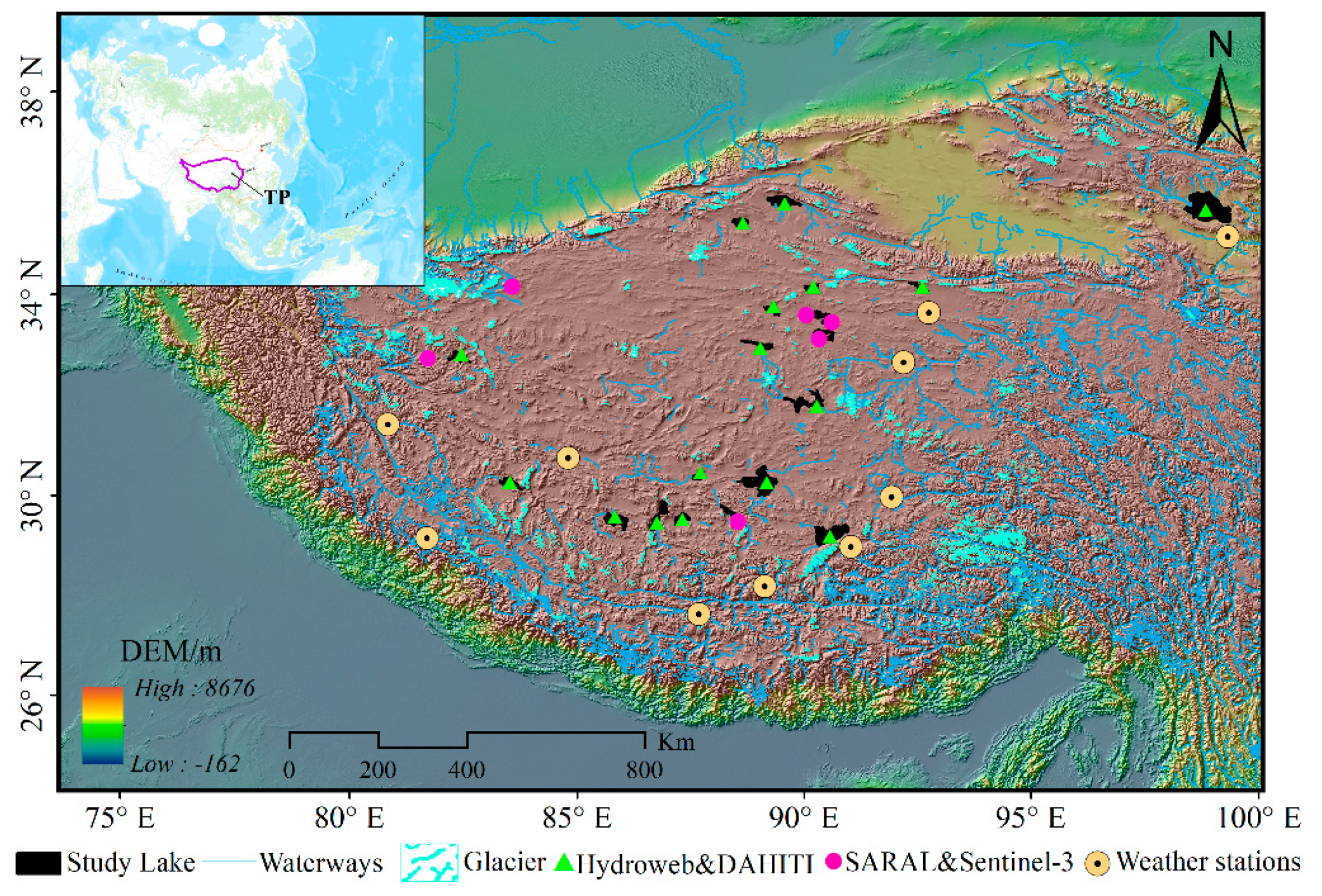
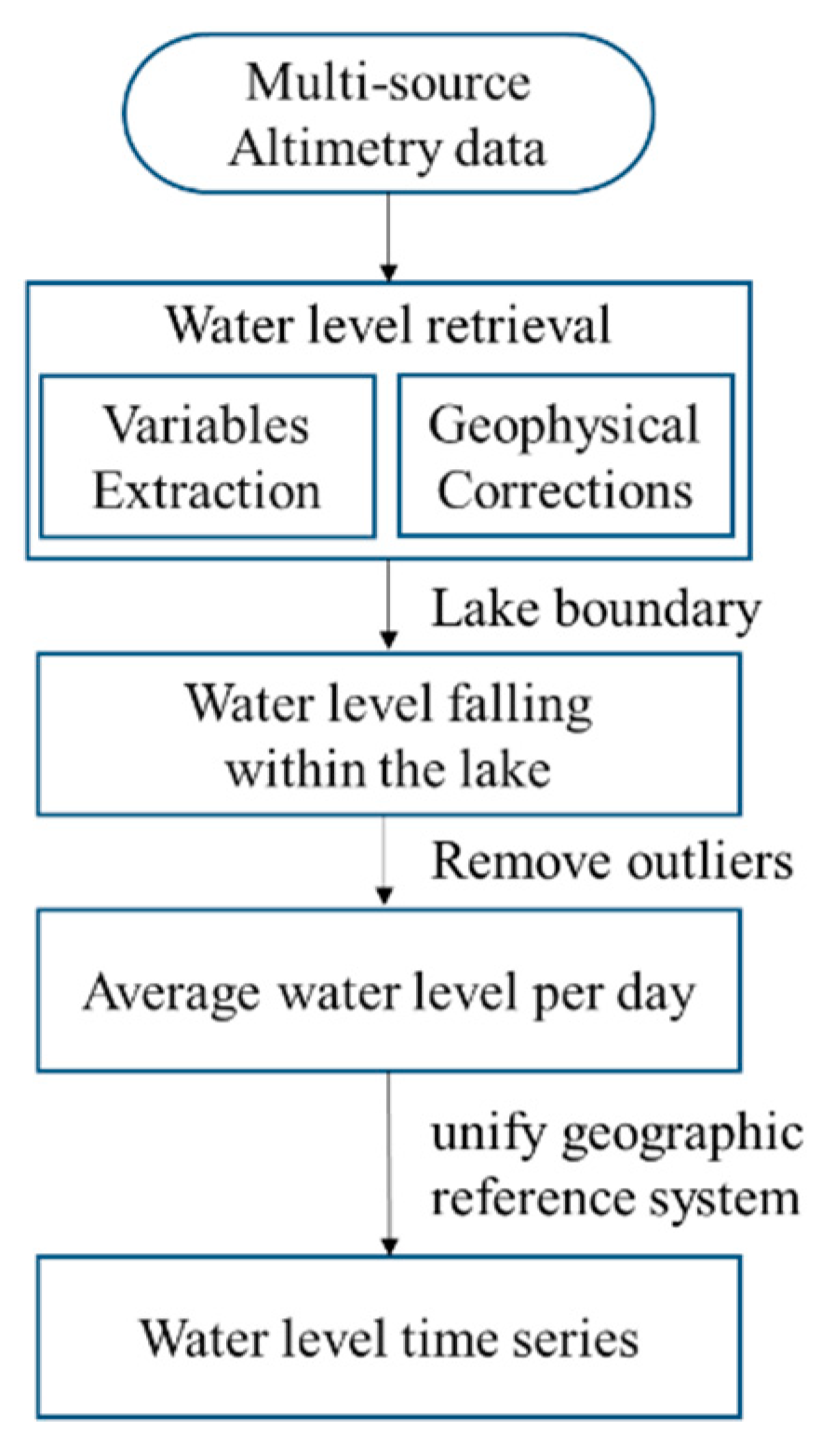
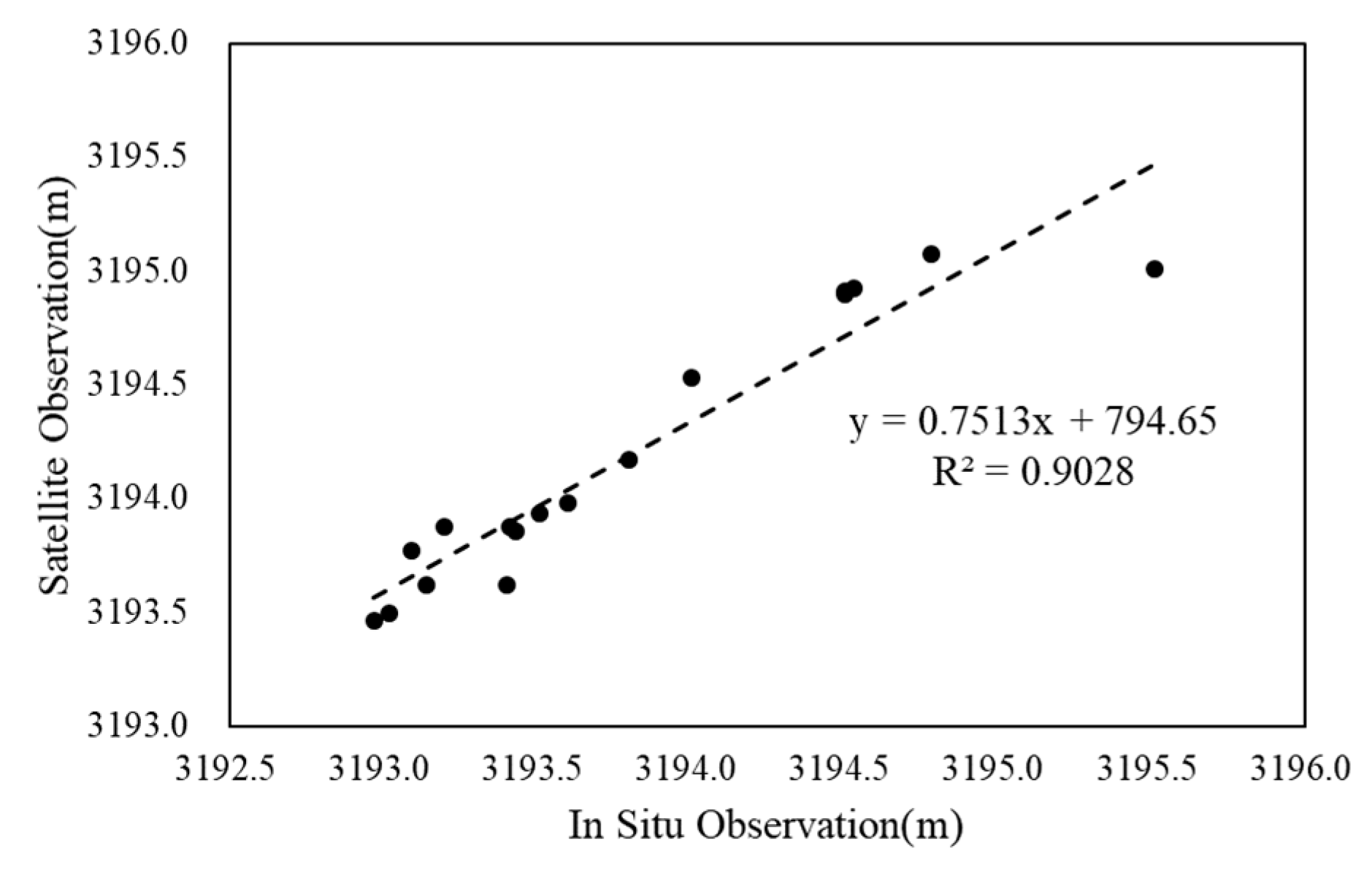

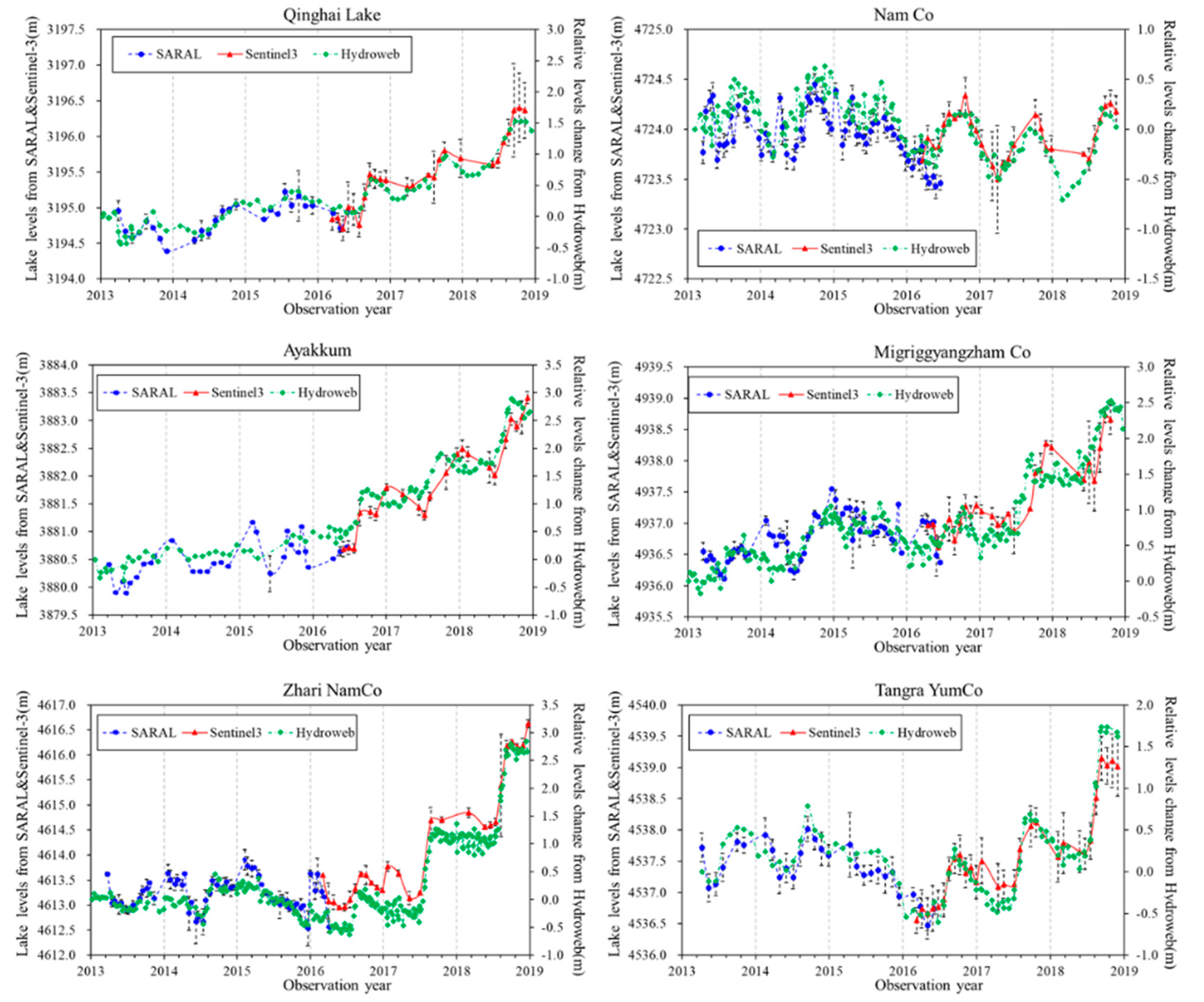
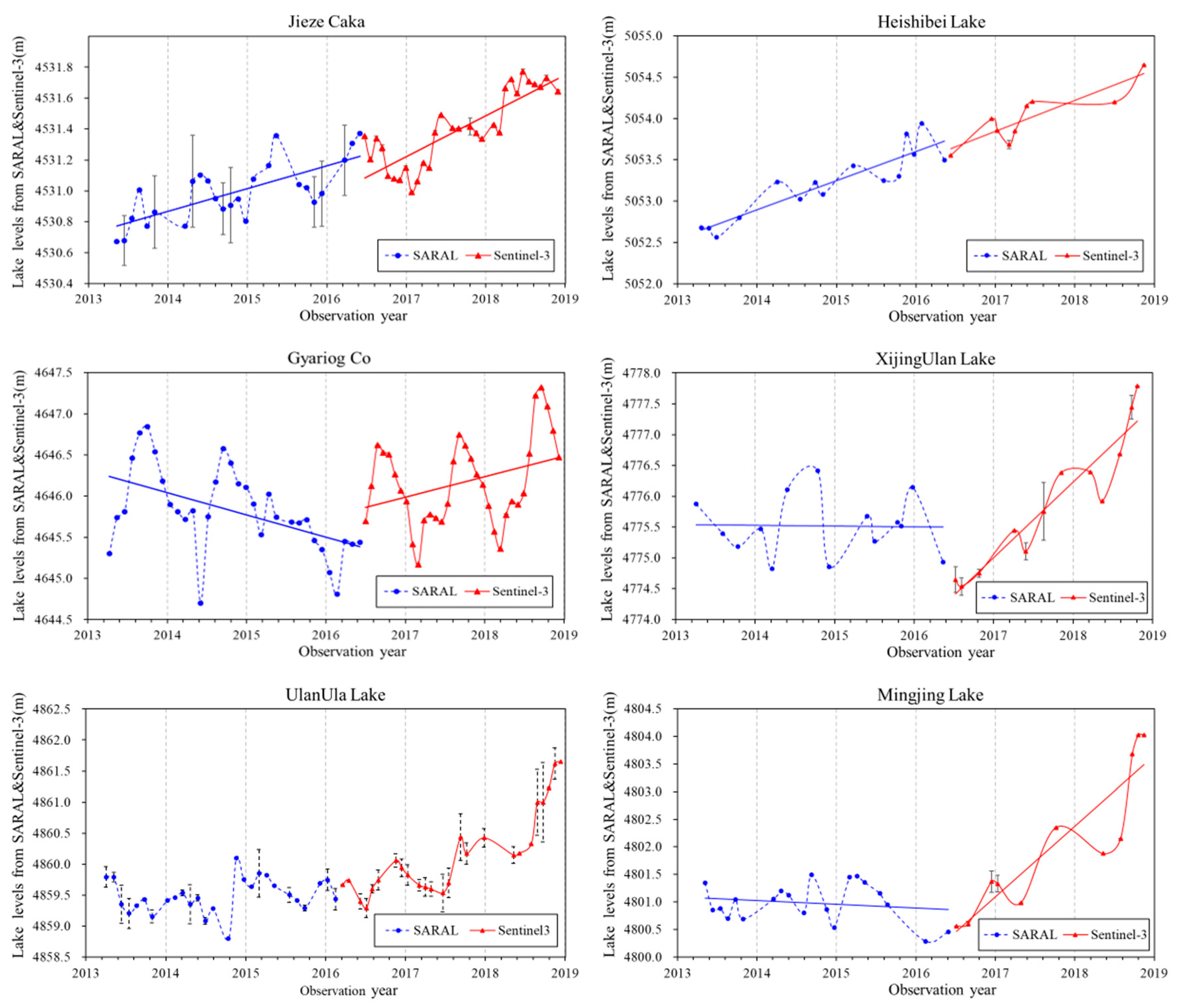
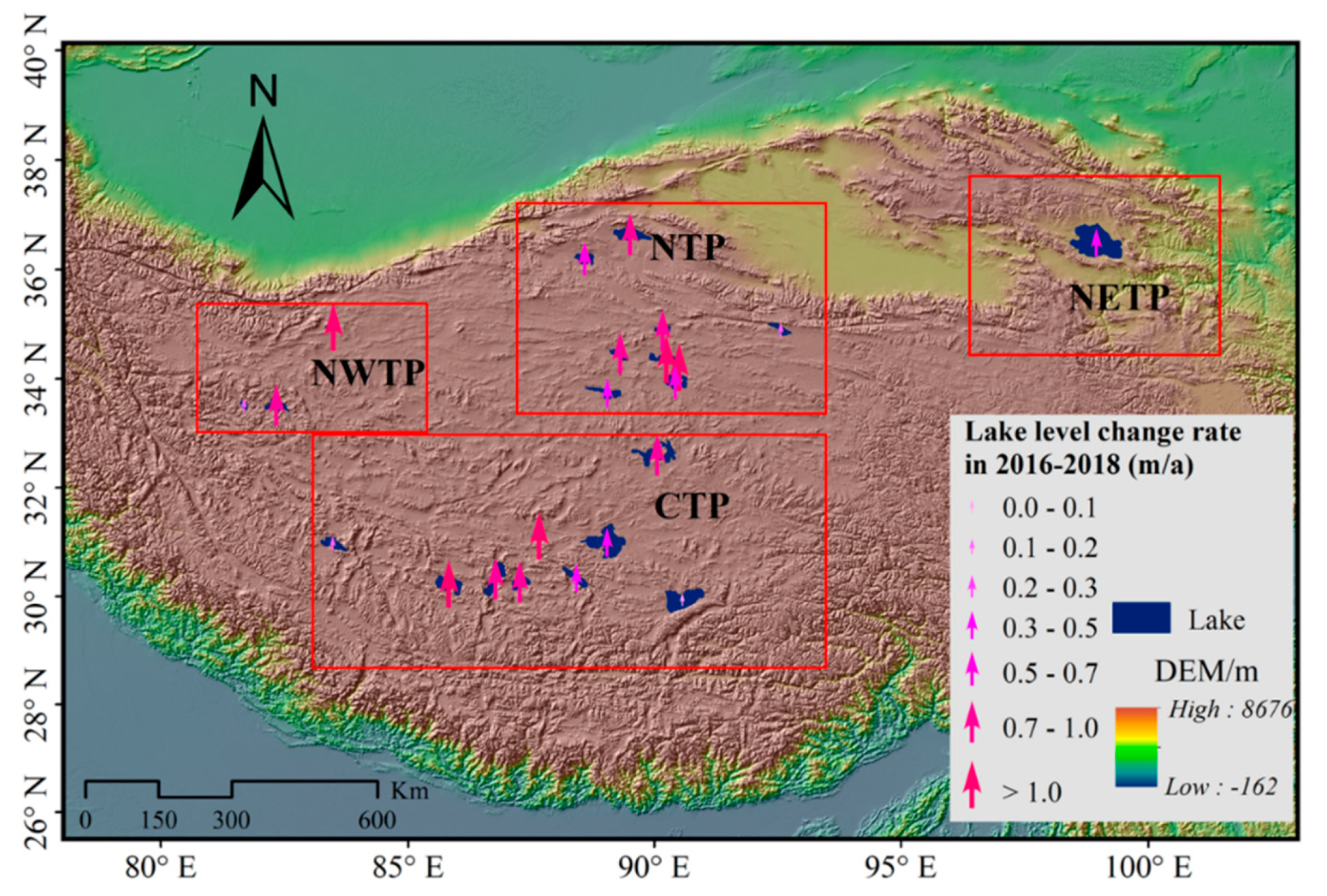
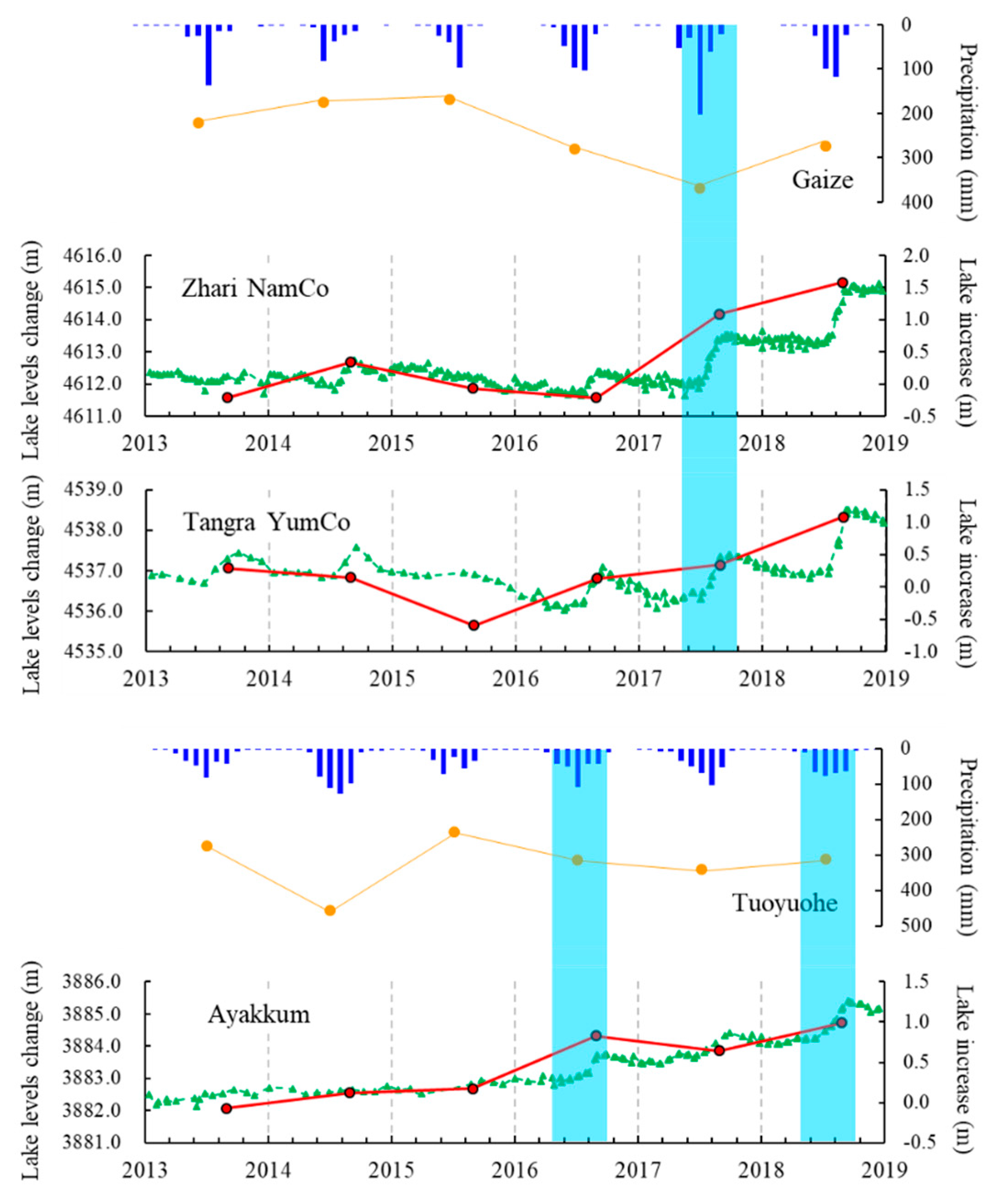

| Mission | Altimeter | Revisit Cycle (Days) | Along-Track Spacing | Footprint | Operational |
|---|---|---|---|---|---|
| Topex/Poseidon | Poseidon-1 | 10 | ~620 m | 2.2 km | 1992–2005 |
| Jason-1 | Poseidon-2 | 10 | ~294 m | 2.2 km | 2001–2013 |
| Jason-2 | Poseidon-3 | 10 | ~294 m | 2.2 km | 2008–active |
| Jason-3 | Poseidon-3B | 10 | ~294 m | 2.2 km | 2016–active |
| ERS-2 | RA | 35 | ~374 m | 1.7 km | 1995–2011 |
| Envisat | RA2 | 35 | ~374 m | 1.7 km | 2002–2010 |
| Cryosat-2 | SIRAL | 369 (30) | ~173 m | 1.6 km | 2010–active |
| SARAL | Altika | 35 | ~173 m | 8 km | 2013–2016 |
| Sentinel-3 | SRAL | 27 | ~300 m | 0.3 km | 2016–active |
| Lake Name | Latitude | Longitude | Lake Area (km2) | Data Source(s) | Satellite(s) |
|---|---|---|---|---|---|
| Jieze Caka | 33.95 | 80.89 | 116.08 | SARAL/Sentinel-3 | SARAL; Sentinel-3 |
| Lumajangdong Co | 34.04 | 81.65 | 389.95 | Hydroweb | Envisat; SARAL; Sentinel-3 |
| Heishibei Lake | 35.58 | 82.77 | 111.93 | SARAL/Sentinel-3 | SARAL; Sentinel-3 |
| Ngangla Ringco | 31.57 | 83.05 | 493.09 | Hydroweb | Envisat; SARAL; ERS2; Sentinel-3 |
| Zhari Namco | 30.94 | 85.57 | 991.73 | Hydroweb | SARAL; Topex/Poseidon; Jason2; Jason 3; Sentinel-3 |
| Tangra Yumco | 31.02 | 86.55 | 841.95 | Hydroweb | Envisat; SARAL; ERS2; Sentinel-3 |
| Ngangze Co | 31.04 | 87.13 | 491.67 | Hydroweb | Envisat; SARAL; Topex/Poseidon; Jason2; Jason3; ERS2 |
| Dagze Co | 31.90 | 87.52 | 305.02 | Hydroweb | Envisat; SARAL; Topex/Poseidon; Jason2; ERS2; Sentinel-3 |
| Aqqikkol | 37.09 | 88.39 | 537.63 | DAHITI | Cryosat-2; Sentinel-3 |
| Gyariog Co | 31.09 | 88.42 | 474.56 | SARAL/Sentinel-3 | SARAL; Sentinel-3 |
| Dogai Coring | 34.56 | 88.99 | 485.26 | Hydroweb | Envisat; SARAL; Jason2; Jason3; ERS2 |
| Seling Co | 31.81 | 89.03 | 2393.53 | LEGOS Hydroweb | Envisat; SARAL; Topex/Poseidon; Jason; ERS2; Sentinel-3 |
| Dogaicoring QiangCo | 35.32 | 89.25 | 394.53 | Hydroweb | Envisat; SARAL; ERS2; Sentinel-3 |
| Ayakkum | 37.54 | 89.43 | 979.85 | Hydroweb | Envisat; SARAL; ERS2; Sentinel-3 |
| Lexiewudan | 35.75 | 90.21 | 270.95 | Hydroweb | Envisat; SARAL; ERS2; Sentinel-3 |
| Migriggyangzham Co | 33.39 | 90.27 | 1066.43 | Hydroweb | SARAL; ERS2; Topex/Poseidon; Jason2; Jason3 |
| Xijin Ulan Lake | 35.21 | 90.32 | 539.76 | SARAL/Sentinel-3 | SARAL; Sentinel-3 |
| Ulan Ul Lake | 34.84 | 90.42 | 646.31 | SARAL/Sentinel-3 | SARAL; Sentinel-3 |
| Nam Co | 30.71 | 90.57 | 2010.60 | Hydroweb | Envisat; SARAL; ERS2; Sentinel-3 |
| Mingjing Lake | 35.06 | 90.58 | 122.61 | SARAL/Sentinel-3 | SARAL; Sentinel-3 |
| Kusai Lake | 35.73 | 92.89 | 327.79 | DAHITI | SARAL; Jason2; Jason3; Sentinel-3 |
| Qinghai Lake | 36.92 | 100.19 | 4493.52 | Hydroweb | Envisat; SARAL; Topex/Poseidon; Jason; ERS2; Sentinel-3 |
| Lake Name | Latitude | Longitude | Elevation (m) | Area (km2) | Lake Type | Change Rate (m/a) |
|---|---|---|---|---|---|---|
| Jieze Caka | 33.95 | 80.89 | 4531 | 113.5 | Y | 0.20 |
| Lumajangdongco | 34.04 | 81.65 | 4817 | 389.9 | Y | 0.86 |
| Heishibei Lake | 35.58 | 82.77 | 5054 | 111.9 | Y | 1.39 |
| Ngangla Ringco | 31.57 | 83.05 | 4715 | 493.1 | Y | 0.15 |
| Zhari Namco | 30.94 | 85.57 | 4613 | 991.7 | Y | 1.34 |
| Tangra Yumco | 31.02 | 86.55 | 4537 | 841.9 | Y | 0.70 |
| Ngangze Co | 31.04 | 87.13 | 4688 | 462.2 | Y | 0.87 |
| Dagze Co | 31.90 | 87.52 | 4471 | 305.0 | Y | 1.43 |
| Aqqikkol | 37.09 | 88.39 | 4251 | 537.6 | Y | 0.58 |
| Gyariog Co | 31.09 | 88.42 | 4647 | 474.6 | N | 0.40 |
| Dogai Coring | 34.56 | 88.99 | 5038 | 485.3 | Y | 0.47 |
| Seling Co | 31.81 | 89.03 | 4544 | 2393.5 | Y | 0.32 |
| Dogaicoring Qiangco | 35.32 | 89.25 | 4787 | 394.5 | Y | 0.82 |
| Ayakkum | 37.54 | 89.43 | 3876 | 979.8 | Y | 0.83 |
| Lexiewudan | 35.75 | 90.21 | 4870 | 271.0 | Y | 0.90 |
| Migriggyangzham Co | 33.39 | 90.27 | 4933 | 1066.4 | Y | 0.70 |
| Xijin Ulan Lake | 35.21 | 90.32 | 4772 | 539.8 | Y | 1.52 |
| Ulan Ul Lake | 34.84 | 90.42 | 4855 | 646.3 | Y | 0.61 |
| Namco | 30.71 | 90.57 | 4724 | 200.6 | Y | 0.01 |
| Mingjing Lake | 35.06 | 90.58 | 4797 | 122.6 | Y | 1.49 |
| Kusai Lake | 35.73 | 92.89 | 4475 | 327.8 | Y | 0.17 |
| Qinghai Lake | 36.92 | 100.19 | 3194 | 4228.3 | Y | 0.47 |
© 2020 by the authors. Licensee MDPI, Basel, Switzerland. This article is an open access article distributed under the terms and conditions of the Creative Commons Attribution (CC BY) license (http://creativecommons.org/licenses/by/4.0/).
Share and Cite
Zhan, P.; Song, C.; Wang, J.; Li, W.; Ke, L.; Liu, K.; Chen, T. Recent Abnormal Hydrologic Behavior of Tibetan Lakes Observed by Multi-Mission Altimeters. Remote Sens. 2020, 12, 2986. https://doi.org/10.3390/rs12182986
Zhan P, Song C, Wang J, Li W, Ke L, Liu K, Chen T. Recent Abnormal Hydrologic Behavior of Tibetan Lakes Observed by Multi-Mission Altimeters. Remote Sensing. 2020; 12(18):2986. https://doi.org/10.3390/rs12182986
Chicago/Turabian StyleZhan, Pengfei, Chunqiao Song, Jida Wang, Wenkai Li, Linghong Ke, Kai Liu, and Tan Chen. 2020. "Recent Abnormal Hydrologic Behavior of Tibetan Lakes Observed by Multi-Mission Altimeters" Remote Sensing 12, no. 18: 2986. https://doi.org/10.3390/rs12182986
APA StyleZhan, P., Song, C., Wang, J., Li, W., Ke, L., Liu, K., & Chen, T. (2020). Recent Abnormal Hydrologic Behavior of Tibetan Lakes Observed by Multi-Mission Altimeters. Remote Sensing, 12(18), 2986. https://doi.org/10.3390/rs12182986







